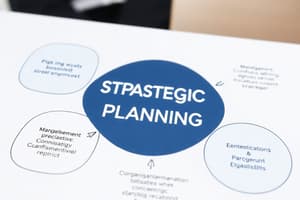Podcast
Questions and Answers
What is the primary purpose of strategic planning in an organization?
What is the primary purpose of strategic planning in an organization?
The primary purpose of strategic planning is to define an organization's overall objectives and the strategies to achieve them.
Name two key components involved in analyzing the external environment during strategic planning.
Name two key components involved in analyzing the external environment during strategic planning.
Market trends and customer preferences.
What does the acronym SMART stand for in the context of setting strategic objectives?
What does the acronym SMART stand for in the context of setting strategic objectives?
Specific, Measurable, Achievable, Relevant, and Time-bound.
Why is it important to regularly review and adapt the strategic planning process?
Why is it important to regularly review and adapt the strategic planning process?
What is the significance of evaluating the internal environment in strategic planning?
What is the significance of evaluating the internal environment in strategic planning?
How should strategic alternatives be developed during the planning process?
How should strategic alternatives be developed during the planning process?
What role do organizational values play in defining the mission and vision?
What role do organizational values play in defining the mission and vision?
List one potential threat and one opportunity that could be identified in the external analysis.
List one potential threat and one opportunity that could be identified in the external analysis.
What is the primary purpose of conducting a SWOT analysis in strategic planning?
What is the primary purpose of conducting a SWOT analysis in strategic planning?
Why is it important to align management practices with strategic goals?
Why is it important to align management practices with strategic goals?
How does effective leadership contribute to the success of a strategic plan?
How does effective leadership contribute to the success of a strategic plan?
What steps are involved in implementing a chosen strategic alternative?
What steps are involved in implementing a chosen strategic alternative?
What role does continuous monitoring play in strategic planning?
What role does continuous monitoring play in strategic planning?
Explain the concept of value proposition in the context of strategic planning.
Explain the concept of value proposition in the context of strategic planning.
What is meant by competitive advantage, and why is it important in strategic planning?
What is meant by competitive advantage, and why is it important in strategic planning?
Describe how strategic planning can enhance an organization’s long-term sustainability.
Describe how strategic planning can enhance an organization’s long-term sustainability.
Flashcards
Management
Management
Coordinating resources (people, money, materials, and technology) to achieve organizational goals.
Strategic Planning
Strategic Planning
Defining an organization's objectives and strategies to achieve them.
Mission/Vision
Mission/Vision
Core values, market position, and desired future state of an organization.
External Analysis
External Analysis
Signup and view all the flashcards
Internal Analysis
Internal Analysis
Signup and view all the flashcards
Strategic Objectives
Strategic Objectives
Signup and view all the flashcards
Strategic Alternatives
Strategic Alternatives
Signup and view all the flashcards
Strategic Evaluation
Strategic Evaluation
Signup and view all the flashcards
SWOT Analysis
SWOT Analysis
Signup and view all the flashcards
Value Proposition
Value Proposition
Signup and view all the flashcards
Competitive Advantage
Competitive Advantage
Signup and view all the flashcards
Strategic Planning Framework
Strategic Planning Framework
Signup and view all the flashcards
Resource Allocation
Resource Allocation
Signup and view all the flashcards
Monitoring & Control
Monitoring & Control
Signup and view all the flashcards
Strategic Planning Benefits
Strategic Planning Benefits
Signup and view all the flashcards
Study Notes
Introduction to Management Principles
- Management involves coordinating resources (people, money, materials, and technology) to achieve organizational goals.
- Effective management is crucial for maximizing productivity, profitability, and efficiency.
- Key principles of management include planning, organizing, leading, and controlling.
Strategic Planning
- Strategic planning is a process that defines an organization's overall objectives and the strategies to achieve them.
- It involves analyzing the internal and external environments, identifying opportunities and threats, and formulating strategies to capitalize on opportunities and mitigate threats.
- Strategic planning is a continuous process that should be regularly reviewed and adapted as needed to reflect changing circumstances.
- It typically involves multiple levels within an organization, from the overall corporate level to the departmental and even individual levels.
Steps in Strategic Planning
- Define the Organization's Mission and Vision: Establishing a clear sense of purpose and aspirations for the future. This involves identifying the organization's core values, its intended market position and its desired future state.
- Analyze the External Environment: Evaluating all factors outside the organization affecting it, including market trends, customer preferences, and competitor moves. This includes identifying threats like competitor action and potential opportunities to expand market share.
- Analyze the Internal Environment: Assessing strengths and weaknesses within the organization. Evaluating resources, processes, and capabilities – such as marketing prowess, operational efficiencies, and organizational structure. This should result in a comprehensive understanding of what the organization can and cannot do.
- Set Strategic Objectives: To translate the vision and mission into specific, measurable, achievable, relevant, and time-bound (SMART) goals for a specific time frame. Defining specific areas in which growth and improvement are required.
- Develop Strategic Alternatives: Examining different possible strategies and approaches to achieve the objectives. This requires thorough evaluation of each alternative to determine its potential impact on the organization's goals.
- Evaluate Strategic Alternatives: Comparing the different approaches based on factors such as potential costs, benefits, risks, and feasibility. Critical assessment of each potential course of action.
- Choose the Best Strategic Alternatives: Selecting the strategy or strategies that best align with the organization's objectives and the analysis performed.
- Implement the Chosen Strategy: Putting the chosen strategy into action, taking necessary steps to execute the plan effectively and efficiently. This may involve allocation of resources and the development of action plans.
- Monitor and Control Results: Tracking progress, making adjustments, and continually evaluating the plan's effectiveness. This should be ongoing, and should measure progress and make refinements as required. This feedback loop allows the organization to learn from its experience, address issues promptly, and enhance its ability to respond to changing environments.
Key Concepts in Strategic Planning
- SWOT Analysis: An important tool for understanding the organization's strengths, weaknesses, opportunities, and threats. It's a framework that can be used to analyze both internal and external factors.
- Value Proposition: Articulating a clear and concise statement of the benefits the organization provides to its customers or clients.
- Competitive Advantage: Understanding and leveraging factors that give the organization a unique position or edge over its competitors. Analyzing what distinguishes the organization and its position in the market.
Management Principles and Strategic Planning Integration
- Strategic planning provides the framework for effective management decisions.
- Management principles (planning, organizing, leading, controlling) should be applied in the implementation and execution of the strategic plan.
- Alignment between management practices and strategic goals is essential for achieving organizational success. For example, a well-defined strategy demands appropriate allocation of resources and a supportive managerial structure.
- Effective leadership is key to motivating employees to achieve strategic objectives.
Importance of Strategic Planning
- Provides a shared direction and purpose, aligning all employees toward common objectives.
- Improves resource allocation, ensuring that resources are deployed to initiatives poised to contribute most to the overall strategic goals.
- Reduces risk and uncertainty by anticipating potential issues and developing mitigation strategies.
- Enhances long-term sustainability by fostering proactive decision-making and adaptability.
- Improves organizational performance by focusing on measurable goals.
Challenges in Strategic Planning
- Maintaining Adaptability: Responding quickly to changes in the marketplace or external environment.
- Aligning Diverse Teams: Ensuring that all members of the organization are aligned with strategic objectives.
- Balancing Short-Term and Long-Term Objectives: Finding a suitable balance between immediate needs and future goals.
- Measuring Progress Effectively: Developing accurate metrics to truly gauge the success of the plan.
Studying That Suits You
Use AI to generate personalized quizzes and flashcards to suit your learning preferences.



